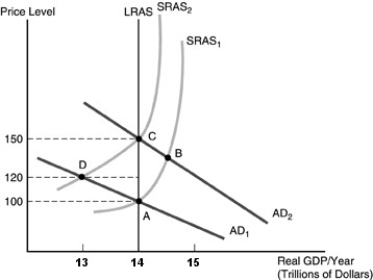
-Refer to the above figure. Suppose the economy is in equilibrium at point A. If the Fed tries to stimulate the economy by undertaking an expansionary monetary policy action and this is not expected by the people in the economy, we would expect to see
A) aggregate demand increases, real GDP increases, and the price level increases. In the long run, aggregate supply would increase and the new long-run equilibrium would be point B.
B) aggregate demand increases, real GDP increases, and the price level increases in the short run. In the long run, people realize the real situation, causing the short-run aggregate supply curve to shift up. Real GDP returns to $14 trillion, and the price level increases to 150.
C) aggregate demand increases but people would anticipate this, causing the short-run aggregate supply curve to shift up at the same time, with the new equilibrium of $14 trillion of real GDP and a price level of 100.
D) aggregate supply shifts up as people anticipate the effects of the expansionary monetary system. In the short run, real GDP falls to $13 trillion and the price level rises to 120. In the long run, real GDP returns to $14 trillion, and the price level increases further, to 150.
Correct Answer:
Verified
Q147: Q159: One key implication of rational expectations is Q161: People combining the effects of past policy Q166: The short run aggregate supply (SRAS)curve shifts Q167: The rational expectations hypothesis states that Q170: A reduction in world oil supplies is Q172: Suppose that the economy is in long-run Q177: Suppose there is an oil supply shock Q180: A key implication of the policy irrelevance Q191: Which statement is TRUE when rational expectations![]()
A) the
Unlock this Answer For Free Now!
View this answer and more for free by performing one of the following actions

Scan the QR code to install the App and get 2 free unlocks

Unlock quizzes for free by uploading documents